人教版英语八年级下册英语第一单元学案
- 格式:doc
- 大小:84.50 KB
- 文档页数:7
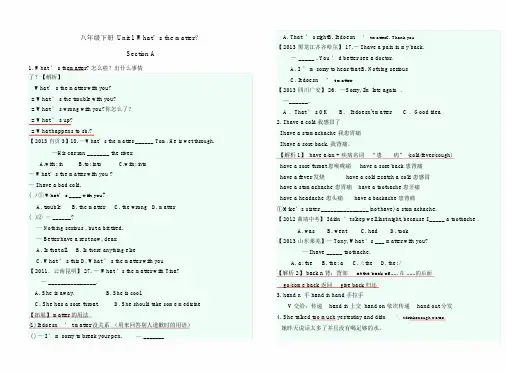
八年级下册 Unit 1 What’s the matter?Section A1.What ’ s thematter? 怎么啦?出什么事情了?【解析】What’ s the matter with you?=What ’ s the trouble with you?=What ’ s wrong with you?你怎么了?=What ’ s up?=What happens to sb.?【2013 自贡 3】18. —What’s the matter ______ Tom. He is wet through.—His car ran _______ the river.A.with; inB.to; intoC.with; into— What’s the matter with you ?— I have a bad cold.() ① What’ s ____ with you?A. troubleB. the matterC. the wrongD. matter()② — ______?— Nothing serious , but a bit tired.— Better have a rest now, dear.A. Is that allB. Is there anything elseC. What ’ s thisD. What ’ s the matter with you【2011.云南昆明】 27. — What ’s the matter with Tina?— _______________.A. She is away.B. She is cool.C. She has a sore throat.D. She should take some medicine 【拓展】 matter 的用法(1)It doesn ’ t matter没关系(用来回答别人道歉时的用语)( ) — I ’ m sorry to break your pen.—_______A. That ’ s rightB. It doesn’ t matterC. Thank you【2013 黑龙江齐齐哈尔】 17.- I have a pain in my back.-_____ . You ’ d better see a doctor.A. I ’ m sorry to hear thatB. Nothing seriousC. It doesn’ t matter【2013 四川广安】 26.—Sorry, I'm late again .—______.A .That ’ s OK B. It doesn't matter C .Good idea2. I have a cold 我感冒了I have a stomachache 我患胃痛I have a sore back. 我背痛。
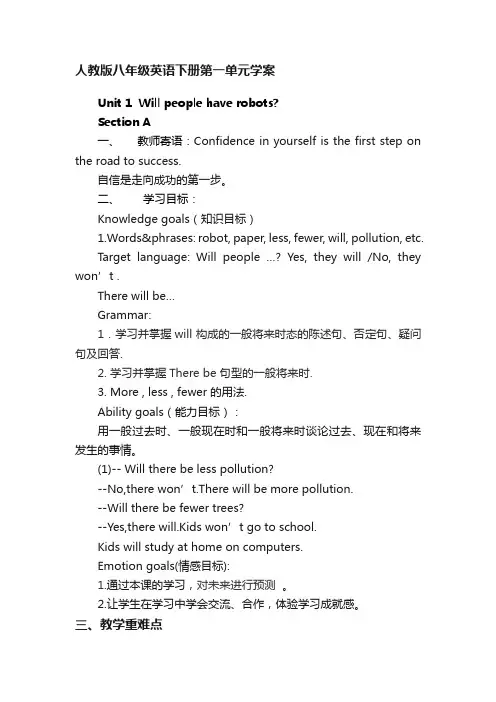
人教版八年级英语下册第一单元学案Unit 1 Will people have robots?Section A一、教师寄语:Confidence in yourself is the first step on the road to success.自信是走向成功的第一步。
二、学习目标:Knowledge goals(知识目标)1.Words&phrases: robot, paper, less, fewer, will, pollution, etc.Target language: Will people …? Yes, they will /No, they won’t .There will be…Grammar:1.学习并掌握will 构成的一般将来时态的陈述句、否定句、疑问句及回答.2. 学习并掌握There be 句型的一般将来时.3. More , less , fewer 的用法.Ability goals(能力目标):用一般过去时、一般现在时和一般将来时谈论过去、现在和将来发生的事情。
(1)-- Will there be less pollution?--No,there won’t.There will be more pollution.--Will there be fewer trees?--Yes,there will.Kids won’t go to school.Kids will study at home on computers.Emotion goals(情感目标):1.通过本课的学习,对未来进行预测。
2.让学生在学习中学会交流、合作,体验学习成就感。
三、教学重难点◆重点由will构成的一般将来时态的句式。
◆难点 1.more,less,fewer的用法。
2.there be 句式的一般将来时态there will be…四、学习过程1、预习导学及自测A.英汉互译1.污染_________2.空闲时间______________3.oncomputers___________4.study at home______5.in 100 years____________6. be free_________B.用more,less,fewer填空:1.There will be ________________(更多的建筑)in 50 years.2.The students will have _______________(更少的家庭作业)to do.3.There will be ________________(更少的污染)here.4.Kids will have ________________(更少的计算机)in their classroom.5.There will be ________________(更多的图书馆)in this city.6.There will be ________________(更少的树)in the park.2、语法小结:一般将来时1)一般将来时由“助动词will+动词原形”构成,表示将来某个时间要发生的动作或存在的状态,常与表示将来的时间状语连用,如:tomorrow,next week,next year,in the future等。
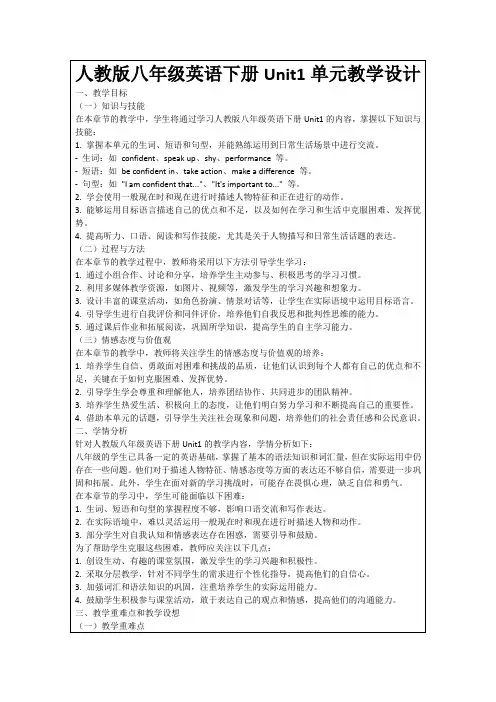
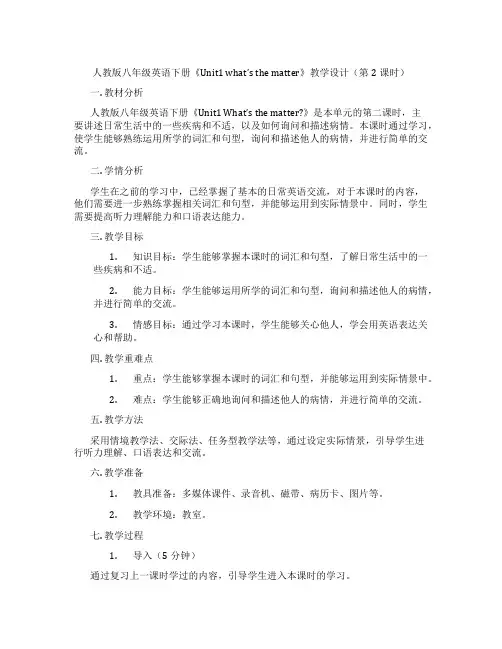
人教版八年级英语下册《Unit1 what’s the matter》教学设计(第2课时)一. 教材分析人教版八年级英语下册《Unit1 What’s the matter?》是本单元的第二课时,主要讲述日常生活中的一些疾病和不适,以及如何询问和描述病情。
本课时通过学习,使学生能够熟练运用所学的词汇和句型,询问和描述他人的病情,并进行简单的交流。
二. 学情分析学生在之前的学习中,已经掌握了基本的日常英语交流,对于本课时的内容,他们需要进一步熟练掌握相关词汇和句型,并能够运用到实际情景中。
同时,学生需要提高听力理解能力和口语表达能力。
三. 教学目标1.知识目标:学生能够掌握本课时的词汇和句型,了解日常生活中的一些疾病和不适。
2.能力目标:学生能够运用所学的词汇和句型,询问和描述他人的病情,并进行简单的交流。
3.情感目标:通过学习本课时,学生能够关心他人,学会用英语表达关心和帮助。
四. 教学重难点1.重点:学生能够掌握本课时的词汇和句型,并能够运用到实际情景中。
2.难点:学生能够正确地询问和描述他人的病情,并进行简单的交流。
五. 教学方法采用情境教学法、交际法、任务型教学法等,通过设定实际情景,引导学生进行听力理解、口语表达和交流。
六. 教学准备1.教具准备:多媒体课件、录音机、磁带、病历卡、图片等。
2.教学环境:教室。
七. 教学过程1.导入(5分钟)通过复习上一课时学过的内容,引导学生进入本课时的学习。
2.呈现(10分钟)教师通过多媒体课件,展示本课时的词汇和句型,引导学生进行学习。
3.操练(15分钟)学生两人一组,进行角色扮演,模拟日常生活中询问和描述病情的情景。
教师巡回指导,纠正发音和表达错误。
4.巩固(10分钟)学生通过听力练习,加深对词汇和句型的理解和运用。
教师及时解答学生的问题。
5.拓展(10分钟)学生分成小组,讨论如何用英语描述他人的病情,并展示给其他同学。
6.小结(5分钟)教师对本课时所学的内容进行小结,强调重点和难点。
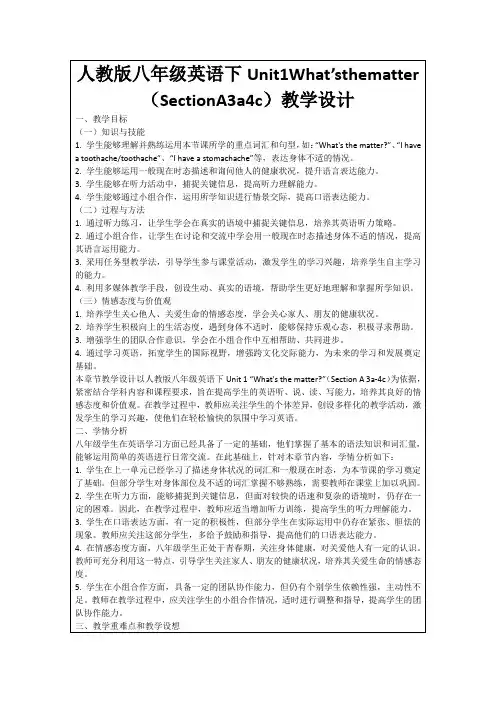
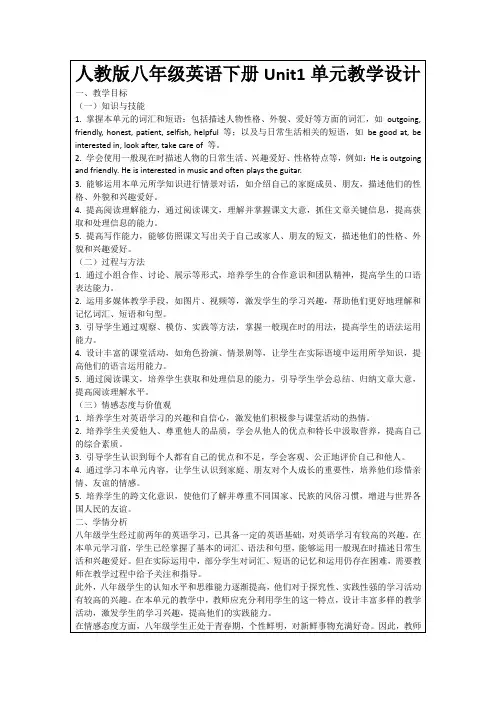
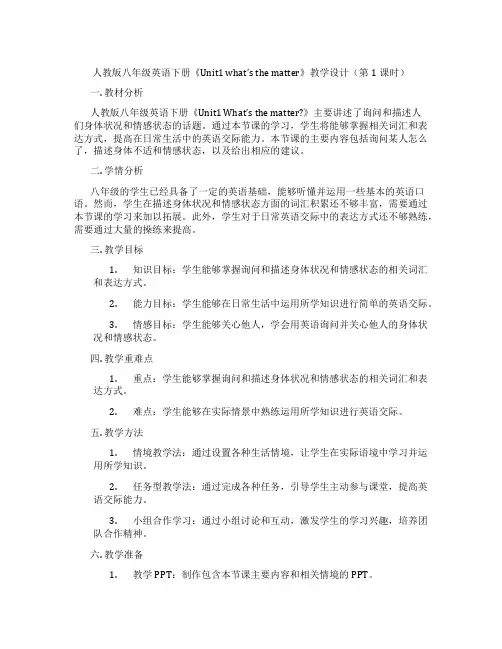
人教版八年级英语下册《Unit1 what’s the matter》教学设计(第1课时)一. 教材分析人教版八年级英语下册《Unit1 What’s the matter?》主要讲述了询问和描述人们身体状况和情感状态的话题。
通过本节课的学习,学生将能够掌握相关词汇和表达方式,提高在日常生活中的英语交际能力。
本节课的主要内容包括询问某人怎么了,描述身体不适和情感状态,以及给出相应的建议。
二. 学情分析八年级的学生已经具备了一定的英语基础,能够听懂并运用一些基本的英语口语。
然而,学生在描述身体状况和情感状态方面的词汇积累还不够丰富,需要通过本节课的学习来加以拓展。
此外,学生对于日常英语交际中的表达方式还不够熟练,需要通过大量的操练来提高。
三. 教学目标1.知识目标:学生能够掌握询问和描述身体状况和情感状态的相关词汇和表达方式。
2.能力目标:学生能够在日常生活中运用所学知识进行简单的英语交际。
3.情感目标:学生能够关心他人,学会用英语询问并关心他人的身体状况和情感状态。
四. 教学重难点1.重点:学生能够掌握询问和描述身体状况和情感状态的相关词汇和表达方式。
2.难点:学生能够在实际情景中熟练运用所学知识进行英语交际。
五. 教学方法1.情境教学法:通过设置各种生活情境,让学生在实际语境中学习并运用所学知识。
2.任务型教学法:通过完成各种任务,引导学生主动参与课堂,提高英语交际能力。
3.小组合作学习:通过小组讨论和互动,激发学生的学习兴趣,培养团队合作精神。
六. 教学准备1.教学PPT:制作包含本节课主要内容和相关情境的PPT。
2.教学素材:准备一些描述身体状况和情感状态的图片或卡片。
3.教学录音设备:用于播放听力材料。
七. 教学过程1.导入(5分钟)教师通过播放一段关于人们描述身体状况和情感状态的听力材料,引导学生关注本节课的主题。
同时,教师可以提问学生:“Can you guess what’s the matter with them?”,激发学生的学习兴趣。
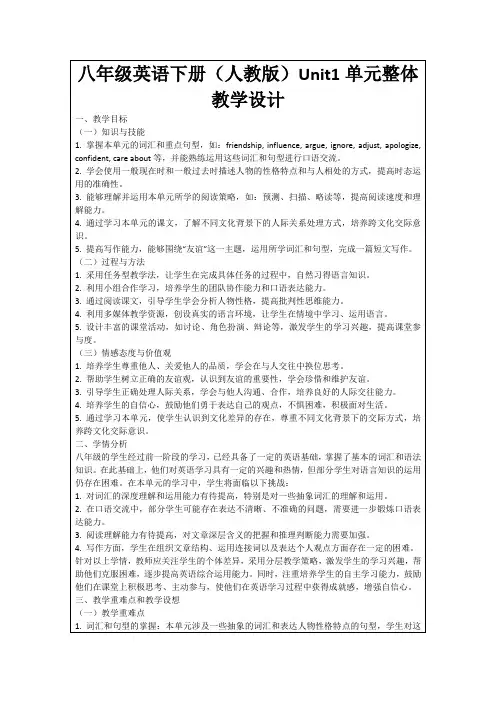
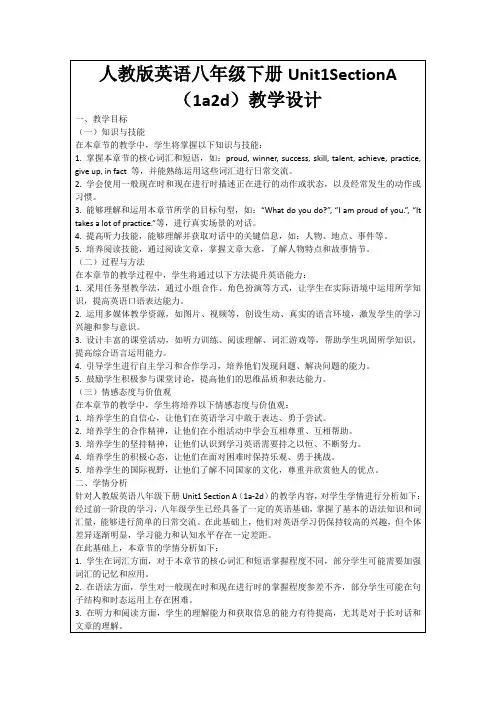
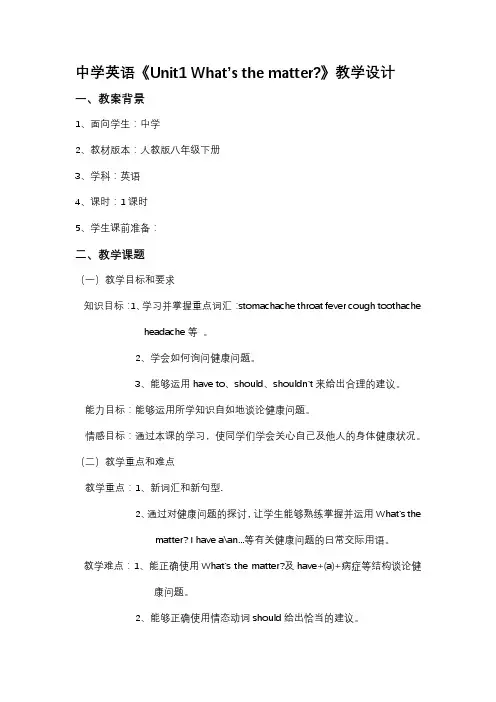
中学英语《Unit1 What’s the matter?》教学设计一、教案背景1、面向学生:中学2、教材版本:人教版八年级下册3、学科:英语4、课时:1课时5、学生课前准备:二、教学课题(一)教学目标和要求知识目标:1、学习并掌握重点词汇:stomachache throat fever cough toothache headache等。
2、学会如何询问健康问题。
3、能够运用have to、should、shouldn't来给出合理的建议。
能力目标:能够运用所学知识自如地谈论健康问题。
情感目标:通过本课的学习,使同学们学会关心自己及他人的身体健康状况。
(二)教学重点和难点教学重点:1、新词汇和新句型.2、通过对健康问题的探讨,让学生能够熟练掌握并运用What’s thematter? I have a\an...等有关健康问题的日常交际用语。
教学难点:1、能正确使用What’s the matter?及have+(a)+病症等结构谈论健康问题。
2、能够正确使用情态动词should给出恰当的建议。
三、教材分析本节课选自人教版八年级下第一单元“What’s the matter? ”的section A部分.本单元通过对健康这一人们生活中必不可少话题的谈论,让学生们学会关于谈论健康状况的一些日常交际用语。
在本课的教学过程中也会通过对表述身体不适句型结构的分析以及情态动词should一词的讲解,让学生进一步掌握有关伤病及处理建议的表达方式。
本节课的教学重点在于对新单词和句型的熟练掌握,只有熟练的掌握才能自如的运用。
难点在于将所学知识熟练的运用,并且能够根据不同的健康问题给予合理的建议。
在教学准备过程中我搜索到了一些与本课相关的能够令学生们感兴趣的图片、录音,寓教于乐让学生们积极的参与到教学过程中,让他们能够充分体会到学习的快乐。
调动他们学习英语的积极性,充分展示学生在教学中的主体地位。
四、教学方法运用task-based method(任务型教学法),借助多媒体手段创设情境让学生产生兴趣,而积极主动的投入到语言环境中。
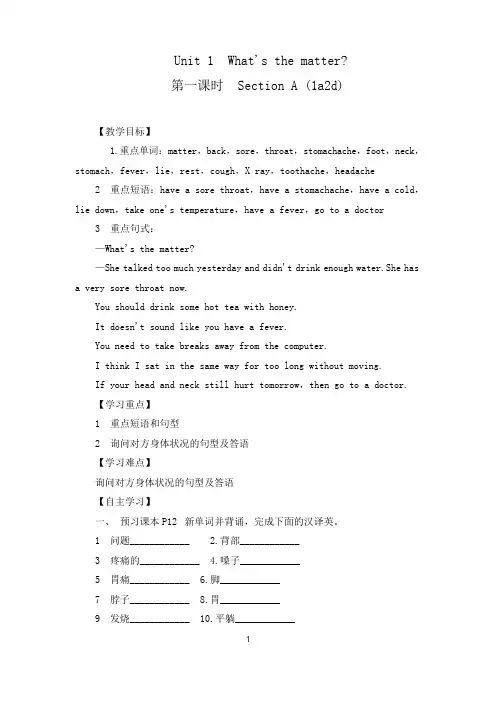
Unit1What's the matter?第一课时Section A(1a2d)【教学目标】1.重点单词:matter,back,sore,throat,stomachache,foot,neck,stomach,fever,lie,rest,cough,X ray,toothache,headache 2重点短语:have a sore throat,have a stomachache,have a cold,lie down,take one's temperature,have a fever,go to a doctor 3重点句式:—What's the matter?—She talked too much yesterday and didn't drink enough water.She has a very sore throat now.You should drink some hot tea with honey.It doesn't sound like you have a fever.You need to take breaks away from the computer.I think I sat in the same way for too long without moving.If your head and neck still hurt tomorrow,then go to a doctor.【学习重点】1重点短语和句型2询问对方身体状况的句型及答语【学习难点】询问对方身体状况的句型及答语【自主学习】一、预习课本P12新单词并背诵,完成下面的汉译英。
1问题____________ 2.背部____________3疼痛的____________ 4.嗓子____________5胃痛____________ 6.脚____________7脖子____________8.胃____________9发烧____________10.平躺____________11休息____________12.咳嗽____________13X光____________14.牙疼____________15头疼____________二、认真预习1a2d找出下列短语和句型。
Unit 1学生通过本讲学习,能够掌握本单元的重点词汇句型,并在综合能力上有一定的拓展。
1.matter的用法(1)名词:事情,问题What’s the matter? =what’s wrong (with you)? =what’s the trouble怎么啦?出什么事啦?(2)动词:有重大影响,有重要性如:What does it matter?2.疾病的表达法have a cold/a fever/ a toothache/ a stomachache3.take 的固定搭配take one’s temperature/ take breaks/ take risks/take some medicine/take off/ take care of/take away 4.surprise的用法1.做名词:to one’s surprise 使。
惊讶的,出乎。
意料2.做动词:surprise sb使某人吃惊3.做形容词:surprising, surprised的用法5.get的用法get off下车/get on上车/get into陷入,参与6.be used to sth/doing sth 习惯于做某事be used to do sth 被用作去做某事used to do sth 习惯于做某事7.out of的固定搭配look out of 向。
外看/ get out of从。
出来/ run out of用光1. --- I'm afraid no one will agree with you. --- I don't think it .A. mattersB. mindsC. worksD. takes2. --- You'd better hurry. We'll be late for the plane.--- Don't worry. The plane will in two hours.A. take outB. take awayC. take off3. --- Why not tell her the good news right now? --- Oh, no. I want to her.A. surpriseB. callC. findD. help4. As soon as he the bus, the poor man realized he had left his wallet on it.A. got onB. got offC. got toD. got in5. Her mother is used to a rest after lunch.A. hasB. haveC. hadD. having解析:1. 本题题意要表达是“我认为它没有关系”故选A2. 此题考的是固定搭配的辨析。
Unit 1 What’s the matter?(1)【学习目标】:知识与技能:1. 能听说读写重点单词和词组:matter, sore, have a cold, stomachache, have a stomachache, foot, neck, stomach, throat, fever, lie, lie down, rest, cough, X-ray, toothache, take one’s temperature,see a dentist2.句型:学会用What’s the matter? I have a cold. I have a stomachache. I have a sore back. I have a sore throat. 谈论身体情况。
3. 学习用should 给出建议过程与方法:向学生展示图片,同时播放录音,让学生努力地听,理解大意;采用学生模仿录音读,并和老师合作对话练习,学生之间对话练习;情感态度与价值观:通过谈论身体状况给出同学相应的建议,可以使同学之间的情谊加深。
【学习重点】:能询问并表述身体的种种不适以及对他人身体的种种不适给予适当的建议。
【学习难点】:用should 给出建议,使用情态动词。
【学法指导】:“组织课堂——复习——导入新课——讲授新知识——操练巩固”来开展教学预习交流把你所知道的身体部位的单词写下来,并写出其相应的中文意思。
eye眼睛_______ ______ ______ ______ ______ ____________ ______ ______ ______ ______ ______ ______ ____________ ______ ______ ______ ______ ______ ______ ____________ ______ ______ ______ ______ ______ ______ ______【合作探究]1、What’s the matter?怎么了,其后常与介词with 连用。
八年级(下)Unit One What’s the matter? 学案(B稿)一;重点单词1._________ . n. 问题;事情_________________________ 怎么啦?v. 要紧,有重要性________________________ 没关系。
2._________ adj. 疼痛的,酸痛的have a sore + ___________have a ______ _______ 嗓子痛have a _______ _______ 后背痛3._______________________ 胃疼/头疼合成词身体部位+ _______ …疼________ n. 疼痛I have ______ ______ in the arm 胳膊疼vi. 疼;疼痛My left hand ________. 我的左手疼。
4. __________ n. 脚;足--(复数pl.)___________ 脚印;足迹__________5.__________ v. 躺;平躺-(-ing) __________ (过去式pf)________ 躺下____________说谎(pf.)____________他说谎成性,没有人信任他。
_____always _______. So nobody ______ ______ him.6.rest v.&n. 放松;休息(同____________)通常在两节课间我们会有十分钟的休息。
We always have ________________________between two classes.休息一会儿,你就会感觉好多了。
Rest for a while, you’ll feel better.7. _________ 休息n. take ________ = take a break 休息= have a rest = rest (v.)v. break 打断;打破(记录);裂;碎-- (pf.) ______________他今早打碎了一个玻璃杯He _______ a glass this morning.8._________ X 射线get __________ X-ray9._________ vi. 疼痛我今天脖子疼My neck ________today.vt. 使…受伤、使…疼痛这鞋很伤脚These shoes ___________________.伤害某人的感情___________________________伤到某人自己___________________________adj. 受伤的她看上去很受伤。
新人教版八年级英语下册unit 1 学案学习目标:1、根据音标正确认读词汇matter — herself。
重点练习发音有难度的单词,如:stomachache,throat ,toothache,headache,passager,trouble等2、掌握新单词的词形转换,如:ache表疾病的表达方式,lie,hurt等重点动词,herself 反身代词。
3、学习学生病痛的不同表达法。
学习过程任务一:1.跟读Unit1部分单词matter — herself2..读准Unit1单词的发音,明确词意。
重点练习读不准的单词,如:delete, housewarming, headmaster任务二:1.完成下列各题1. What’s the matter (with you)?(汉译))____________________________________同义句:W hat’s/ / with ./ sth.?2. I had a cold.我感冒了。
have a cold=catch a cold=have the fluhave a fever have a cough________________have a stomachache___________________ have a toothache__________________have a headache___________________3. lie down躺下,lie(汉译)____________,过去式_________;lie(汉译)_____,过去式lied4. trouble问题,麻烦;be in trouble ,make trouble ,have trouble (in) doing sth. =have difficulties (in) doing sth5. hurt (汉译)______________,三单________________过去式______________知识梳理:归纳本节课所学习的重点单词用法。
八年级下册Unit 1 What ’s the matterSection A1. What’ s the matter 怎么啦出什么事情了 【解析】What’ s the matter with you = What’s the trouble with you = What’ s wrong with you 你怎么了 = What’s up = What happens to sb.【2013自贡3】18. —What ’s the matter ______ Tom. He is wet through. —His car ran _______ the river.; in ; into ; into — What’s the matter with you — I have a bad cold.( ) ①What’s ____ with youA. troubleB. the matterC. the wrongD. matter ( )② — ______— Nothing serious , but a bit tired. —Better have a rest now, dear.A. Is that allB. Is there anything elseC. What’s thisD. What’s the matter with you 【2011.云南昆明】27. —What ’s the matter with Tina —_______________.A. She is away.B. She is cool.C. She has a sore throat.D. She should take some medicine【拓展】matter 的用法(1) It doesn’t matter 没关系 (用来回答别人道歉时的用语) ( ) — I’m sorry to break you r pen. —_______A. That’s rightB. It doesn’t matterC. Thank you 【2013黑龙江齐齐哈尔】17.-I have a pain in my back. - _____ . You’d better see a doctor. A. I’m sorry to hear that B. Nothing seriousC. It doesn’t matte r【2013四川广安】26.—Sorry, I'm late again . —______.A .That’s OKB .It doesn't matterC .Good idea 2. I have a cold 我感冒了I have a stomachache 我患胃痛 I have a sore back. 我背痛。
【解析1】 have a/an + 疾病名词 “患……病” (cold/fever/cough) have a sore throat 患喉咙痛 have a sore back 患背痛 have a fever 发烧 have a cold =catch a cold 患感冒have a stomachache 患胃痛 have a toothache 患牙痛 have a headache 患头痛 have a backache 患背痛 ①Mike’s sister _________________(not have) a stomachache.【2012曲靖中考】I didn’t sleep well last night, because I _____ a toothache .A. wasB. wentC. hadD. took 【2013山东莱芜】—Tony, What’s ___ matter with you — I have _____ toothache. A. a; the B. the; a C. /; the D. the; /( ) Mr. Smith eats ______ food, so he’s _____ fat.A .much too; too muchB .too many; much tooC. too much; too muchD. too much ;much too【2013孝感】—Why are you so tired these days—Well, I have ________ homework to do.A. too muchB. too manyC. muchtoo D. many too【解析2】enough 的用法(1) adj.足够的,充分的修饰名词时,可放在名词之前或之后enough time(2) adv. “足够地,十分,相当”修饰adj./adv,放在adj./adv 后expensive enough(3) be +adj. +enough to do sth be strong enough to carry the box. ( ) ①The boy isn’t ___ to dress himself.A. old enoughB. enough old( ) ②—What do you think of the lecture of Li Yang’s Crazy English —I think it’s _____ , but someone thinks it’s much too _____.A. wonderful enough; boredB. enough wonderful; boringC. wonderful; enough; boringD. enough wonderful ; bored5. drink some hot tea with honey.喝一些加蜂蜜的热茶。
【解析】with :⑴prep “具有,带有” ,表示某物带有或具有某种特征。
She is a girl with long hair.with (反)without( ) He has a sore throat . He should ______.A. see a dentistB. drink hot tea with honeyC. drink a lot of milkD. eat nothing【2013达州3】15. —Which would you prefer, coffee or orange juice— Either _________ OK, but I prefer coffee__________milk in it., with B. is, to C .is, with D. are, to 【2013连云港】30. —I'd like a cup of black coffee. What about you, Maggie— I prefer coffee ________ sugar.A. thanB.for C. with D. to⑵prep. 和......一起I like to talk freely with my friends.⑶prep 用......,表示“使用某种工具”Cut it with a knife.6. see a dentist and get an x- ray. 看牙医并且拍张x光。
【解析1】see a dentist = go to a dentist看牙医see a doctor = go to a doctor 看医生【解析2】X-ray/'eks rei/n. X 射线;X 光【2011湖南湘西】You are ill. You had better ___ the doctor right now.A. look atB. seeC. watch【2012四川成都】33. —Where did you go yesterday, Rick—I went to see a ______ because I had a cold.A. teacherB.doctor C. reporter7. What should she do她该怎么办呢Should I take my temperature我应该量一下体温吗【解析1】s hould “应该”情态动词,后跟动词原形,表示责任和义务should not =shouldn’t不应该主语+ should/ shouldn’t +动词原形. ..①You should lie down and rest. 你应该躺下休息一会儿。
②You shouldn’t’ t go out at night.你晚上不应该出去。
( ) ②You ____ be quiet when you are in the reading room.A. shouldB. shouldn’tC. canD. can’t 【2013山西】21. A country has dreams. We teenagers ________ also have dreams. With dreams and hard work, anything amazing can be created.A. mayB. mustC. should【2013安徽】You _____ drive your car so fast. It’s very dangerous.A. wouldn’tB. shouldn’tC. couldn’tD. mightn’t【解析2】take one’s temperature量体温8. No, it doesn’t sound like you have a fever. 不需要,听起来你不像发烧了。
【解析1】sound like 听起来像,后接名词或名词性短语作表语。
It sounds like a good idea.【拓展】“感官动词+ likefeel like 摸起来像smell like 闻起来像look like 看起来像taste like 尝起来像【解析2】fever/ 'fi:v:(r)/n.发烧have a fever 发烧You need to take breaks away from the computer.你需要休息一下,远离电脑。
9. You need to take break away from the computer.你需要远离电脑,休息休息。